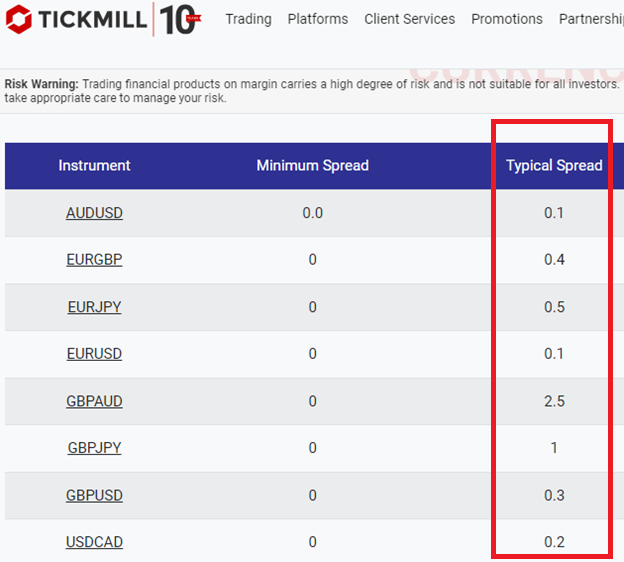Standard Accounts
Standard Accounts are Spread-only Accounts that have a straightforward pricing structure as there are no commission payments.
However, Standard Accounts have wider & less transparent spreads making you take longer to reach profit on a trade because you must overcome the spread first which shows as a negative balance when you enter a trade.
The issue of poor transparency is a major one with Standard Accounts because most brokers offer variable spreads which can change at any time.
This means when volatility is high in the market, your broker can choose to widen the spread without informing you.
To offer more transparency, some brokers show you average/typical spreads which are basically an estimate of where the spreads will be most of the time.

However, even average/typical spreads are just an estimate & are not a guarantee. The spreads can still widen at any time & you may be too busy to notice.
The advantage of Standard Accounts is that you can exit a trade without making a profit and your account balance will still be the same.
This is possible because when you enter a trade, you being in a negative balance (which is the spread) so once you profit pays off the spread, your profit/loss becomes 0.00 & you can close the trade without it affecting your final account balance.
Their disadvantage is that your trades take a longer time to break-even & become profitable plus there is less transparency on Standard Account spreads.
Who Should Open a Standard Account?
Beginners who intend to trade with little to medium capital should consider opening Standard Accounts.
Why? because although the spreads are less transparent, the pricing style is easier to understand. Once you open a trade, the spread is automatically deducted leaving you in negative.
However once you start making profit & clear the negative balance, you know you are not owing the broker fees again.
In fact after paying off the spread & getting your trade out of negative balance, you can choose to close the trade & exit the market and your account balance will still be the same.
| Pros | Cons |
| ✅You can exit a trade without making a profit & your account balance will remain the same | ❌Spread can be widened without notice |
| ✅Standard Accounts come with lower minimum deposit | ❌Spread acts as a barrier: You take a longer time to reach profitability on each trade |
| ❌Some brokers exclude standard account users from using high-end features |
Raw Accounts
A Raw Account is a Commission based account where the broker does not control the spread. The spread on a Raw Account comes directly from liquidity providers (such as Banks & Oil Companies) so they control the spread.
Usually these liquidity providers take very low spreads (near zero) for major currency pairs.
This enables Raw Accounts to offer tighter spreads, meaning your trades can reach profitability faster.
However, you still pay low spread on a Raw Account but it is lower than what Standard Accounts offer. You also pay a flat commission on every trade when you use a Raw Account.
The advantage of Raw Accounts is that although you pay commissions on every trade, it takes a shorter time for your trades to turn green & become profitable. You spend less time in the market.
The disadvantage of Raw Accounts in forex is that if you exit a trade without making a tangible profit, you end up with losses after commission is deducted at the end.
For example if the commission on EUR/USD is $3 per side, it means after the trade you will pay $6 because the buy part of the trade is one side, & the sell side of the trade is another side.
Both sides are summed up and called a round turn so $3 per side is actually $6 per round turn.
So, if commission is say $6 per round turn and you exit your trade after making a $2 profit, you still end up with a $4 loss after commissions are deducted from your trading account balance.
Another disadvantage of Raw Accounts is that they don’t offer zero spread on every currency pair. So, if you are trading a currency pair with say 0.2 pip spread, you cannot exit the market after paying off the spread because you still have to make enough profit to cover the compulsory commission that will be deducted at the end.
Not doing this will mean you close a trade with a profit only to realize the commission has wiped off the profit.
Who Should Open a Raw Account?
Raw Accounts offer transparent spreads which is desirable for traders with large account balance & capital.
When trading with huge capital, you will demand some level of transparency. You may not want to deal with sudden widening of spread without your notice because even the slightest increase in spread, can be material when big money is involved.,
This is why high volume traders prefer Raw Accounts where low/zero spread is offered if they agree to pay flat commissions at the end of each trade.
This is also the reason why Raw Accounts always have higher minimum deposits.
| Pros | Cons |
| ✅Transparent spreads | ❌You pay a commission on each trade |
| ✅Lower spreads | ❌A compulsory commission is charged at the end of the trade |
| ✅Raw Accounts users can get rebates & discounts on commission when they trade high volumes | ❌ Raw Accounts usually have higher minimum deposits |
| ✅Raw Account users are given more priority & perks by forex brokers. So they can enjoy special/advanced features on the trading platform | ❌Your profits must be enough to cover the commissions that will be deducted after the trade |

Leave a Reply